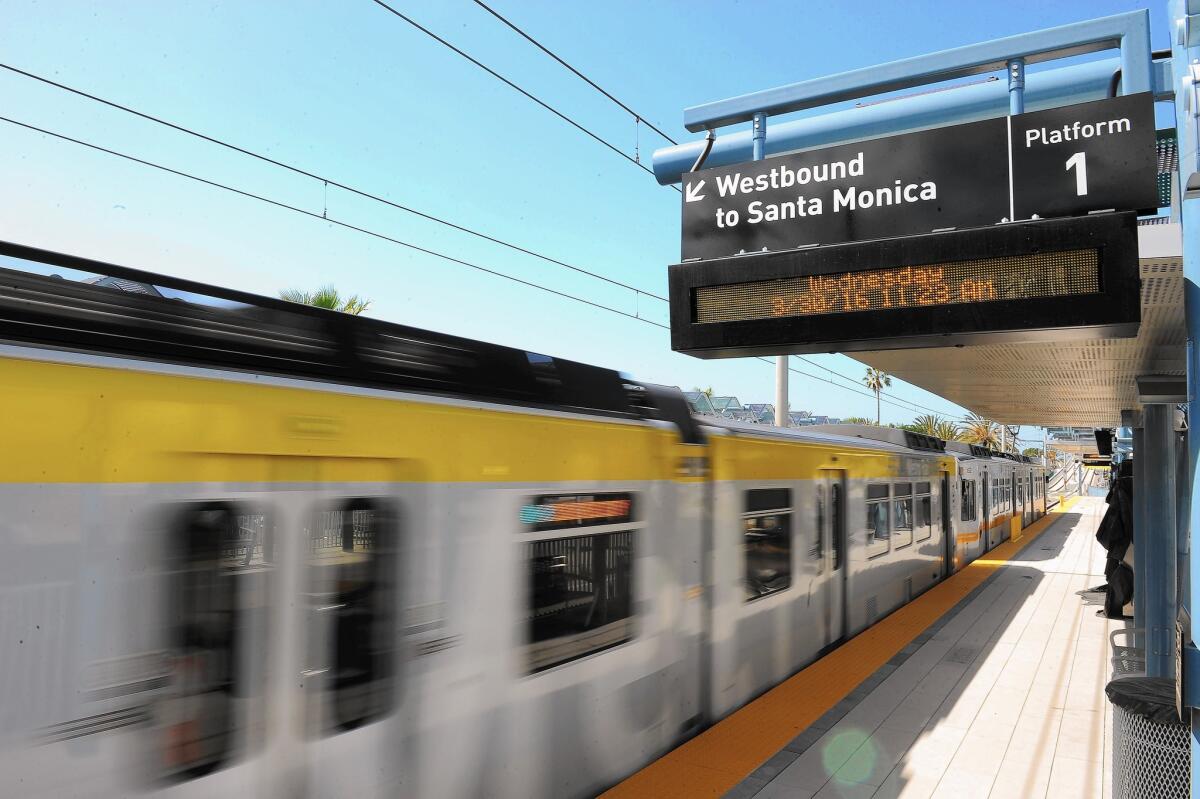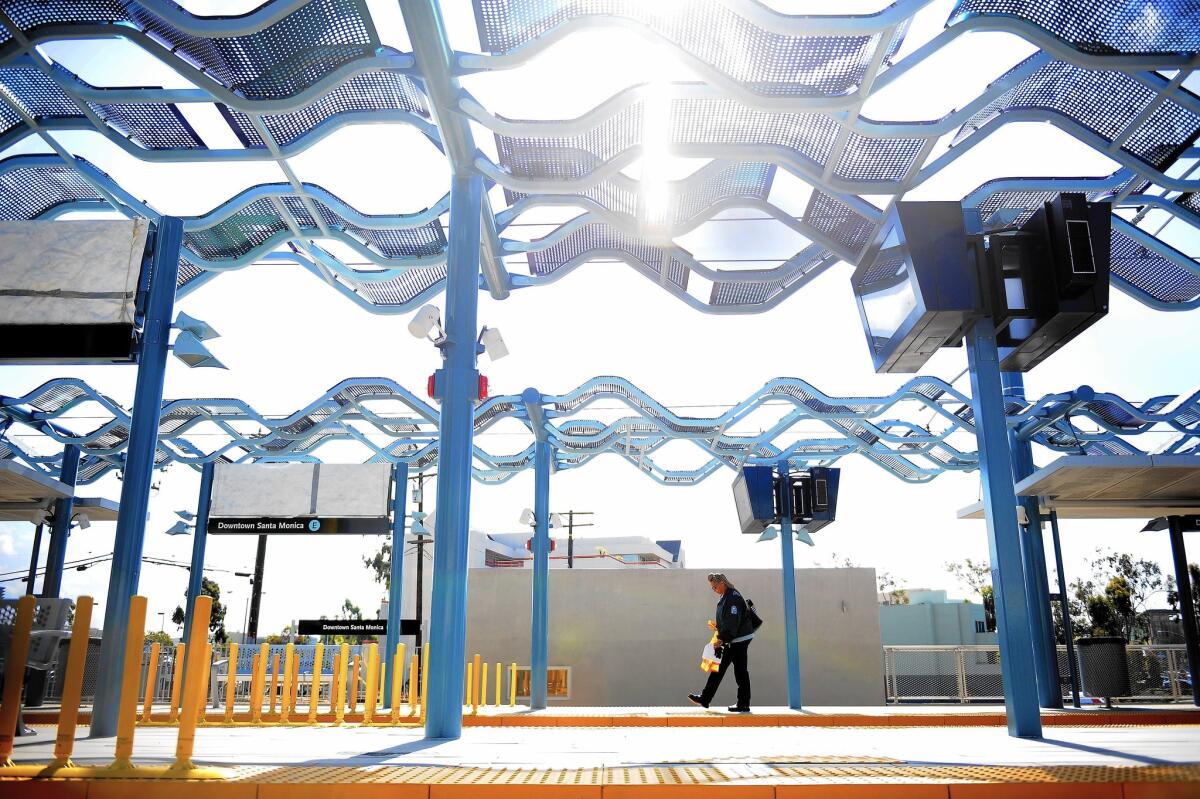Will Santa Monica’s Expo Line get you out of your car?
- Share via
Each day, about 80,000 people travel to Santa Monica for work. At the same time, about 45,000 Santa Monica residents head to jobs outside the city.
Most drive solo, often on jammed freeways.
Even the biggest public-transportation boosters acknowledge that next month’s arrival of the Expo Line — the first passenger rail service to a Westside beach in more than half a century — isn’t going to change habits overnight.
Still, the rail extension is an opportunity that Santa Monica officials intend to take full advantage of.
Now is the chance, they say, for the city of about 92,000 to serve as a model of mobility.
A lot is riding on this effort. Los Angeles County is in the midst of a major expansion of rail service — four new routes are under construction this year — and transit officials are struggling to boost ridership.
This latest stretch of track, which rolls through key tech and entertainment job centers all the way to the ocean, offers a fresh chance to lure new riders.
Santa Monica officials have been working hard to give the train a central role in the city. They hope to use it to broaden the way people think about how they travel, to get them to contemplate alternatives to their bumper-to-bumper car journeys.
Taking the train, of course, carries its own set of challenges — notably getting to a station, and from a station to a destination. But the city plans to highlight the relatively easy ways in which these hurdles can be overcome.
For so long, people in the L.A. area had little choice but to get in their cars and drive from Point A to Point B, Santa Monica City Manager Rick Cole said. Now they have options.
They can take the bus to the train. They can take a ride share from the train. They can travel all the way or part of the way to their destinations by bike share.
Santa Monica hopes to make the array of possibilities evident on May 20, when the first Expo Line passengers disembark at the 26th St./Bergamot, 17th St./Santa Monica College and downtown Santa Monica stations.

Commuters will be able to see right away where to pick up one of the new Breeze bike share rides or wait for an Uber or Lyft or a Santa Monica Big Blue Bus or Metro bus. There will be signs pointing out the places one might want to head on foot.
Santa Monica Pier is just a few blocks west of the downtown station at 4th Street and Colorado Avenue. The city is building a promenade between the two. Called the Colorado Esplanade, it will transform a previously vehicle-filled stretch of Colorado Boulevard into an inviting passageway favoring the pedestrian and cyclist.
One lane of traffic — heading west — will remain open. But the rest of the space will give way to a wide sidewalk and dedicated bike lanes. At night, the esplanade will be illuminated by festive strings of lights hanging between yellow poles.
It’s not enough, Cole said, to rely on the old “if you build it, they will come” cliche. To get people to use the Expo Line and other forms of transportation, the experience will have to be appealing and convenient.
And ensure that travelers feel safe.
To that end, the city is adding 11 so-called pedestrian scrambles — which stop all car traffic through an intersection while those on foot cross in every direction, including diagonally.
People usually are willing to walk about 10 minutes, Cole said. With the scrambles, from the downtown Expo station “you can pretty much get to most of downtown” in that amount of time, he said. “And if it’s shaded and pleasant, then we think people will do it.”
Santa Monica has been making tweaks for months now, all over the city — adding street lights and bike racks, building out curbs to shorten busy crossings and making them less intimidating to pedestrians. Main Street is being revamped, with wide sidewalks and bike paths, so that it flows directly into 2nd Street — smoothing the connection between the Civic Center area and downtown.
It’s a lot like working on a big jigsaw puzzle, trying to fix some of the issues that prevent people from looking beyond their cars to get from place to place.
The Big Blue Bus system, for instance, has overhauled its routes — tweaking some old ones and adding six more to make sure there are easy connections to and from each of Santa Monica’s three Expo Line stops (as well as four others in its 56-square-mile service area.)
“It’s really a once-in-a-lifetime opportunity for the Westside and the city of Santa Monica to enhance mobility for residents and to really get people out of their cars to try public transit,” said Ed King, the bus system’s director of transit services. He, by the way, drives and carpools to his Santa Monica office from Long Beach.
In the past four years, Santa Monica has grown its network of dedicated bike lanes, climbing lanes and lanes marked with “sharrows” from 35 miles to 105, said Francie Stefan, the city’s mobility manager. And between its November launch and the middle of April, the Breeze Bikeshare program — which has 80 stations throughout Santa Monica — logged 15,000 members and 74,000 trips.
Highlighting all of these changes is a way, Cole said, of leveraging the Expo Line extension to maximize its benefits to the city.
Opening day plans call for a big party along the new rail route. Train and bus rides will be free. The Big Blue Bus system also will offer a 2-for-1 special: Buy a May bus pass and get June for free. On Sunday June 5, Santa Monica will hold Coast, its version of CicLAvia — shutting off about two miles of street around the downtown Expo station to car traffic so that people can enjoy them on bikes and on foot.
See more of our top stories on Facebook >>

Santa Monica Pier is a few blocks from the 4th Street/Colorado Avenue station. The city is building a promenade between the two.
And because Cole suspects that a good portion of people’s resistance to public transit is psychological — and that some of that is embarrassment about not understanding how to use it — Santa Monica is planning back-to-basics public education on things like how to use a TAP card and how much the bus costs.
In the run-up to the Expo Line extension, much of the focus has been on taking the train to the beach.
On summer weekends, the city can draw more than 200,000 visitors, Cole said. In the next few months, some folks surely will roll up their towels and give that 46-minute train trip from downtown L.A. a try.
But chances are the percentage of train-taking beachgoers will be low. That’s OK, Cole said. Change will happen. It has to.
How many more cars, after all, can jam their way onto the 10 Freeway — whose stretch from downtown L.A. to Santa Monica recently was named one of the 10 most-congested roadways in the world? Cole knows just how bad it is. He drives to work from Los Feliz — among the 80% of municipal employees who live outside Santa Monica.
“Cities don’t change overnight, and people don’t change overnight,” he said.
“We’re not asking people to sell their cars. We just want them to try some other options. And that will take time. It’s like learning a new language.”
Twitter: @latimescitybeat
MORE LOCAL NEWS
6 paid sick days for workers in L.A.? City Council says yes
Major earthquake overdue in California’s Eastern Sierra, study finds
‘The World’s Fastest Stoner’ does his part to blunt the lazy pot-smoker stereotype
More to Read
Sign up for Essential California
The most important California stories and recommendations in your inbox every morning.
You may occasionally receive promotional content from the Los Angeles Times.














